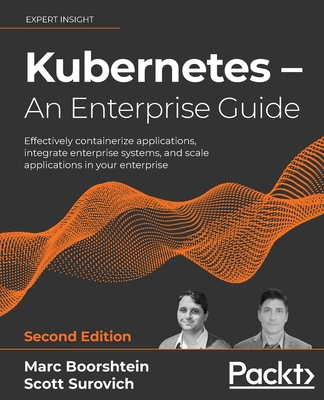-
出版商:
Independently Published
-
出版日期:
2019-07-25
-
售價:
$500
-
貴賓價:
9.5 折
$475
-
語言:
英文
-
頁數:
70
-
裝訂:
Quality Paper - also called trade paper
-
ISBN:
1082736325
-
ISBN-13:
9781082736322
-
相關分類:
Microservices 微服務、Google Cloud
商品描述
Containers are becoming a standard way to run and scale microservices across multiple cloud providers. With Kubernetes, the job of deployment, scaling, and management of containerized applications on cloud or on promises is now mainstream and extremely streamlined.To build a production grade environment, however, you need a host of other components like Virtual Private Network (VPN), endpoint management for microservices, load balancer to balance request over various protocols (HTTP, HTTP(s), Web socket), Configuring SSL, Health monitoring of services, Network configuration like Whitelisting of IPs, Network address translation (NAT) for Outbound connections, and ensuring logging at various entry points in your application.In this book, we will go through the steps to create a production ready environment on Google cloud for deploying microservices.The book assumes you are familiar with Kubernetes and Google cloud. The book introduces some of the concepts briefly while setting up the production environment and deploying the solution.We would be deploying a set of micro services (as containers) on Google Kubernetes Cluster. We would use Google Endpoints for API management and deploy the google endpoint container along with our microservices container. We would further create an Ingress Controller (of type Load Balancer) and expose our application microservices over HTTPS. All incoming HTTPS requests would go to a Load balancer, which would direct them to one of the nodes in the Kubernetes Cluster. In the nodes, the requests would first go to Google endpoint (which would validate the endpoint key and logs all endpoint request) and then to the respective microservice endpoints.There are additional requirements on ensuring only authorized IPs access our microservices. We will learn how to whitelist the IPs using two approaches - Google Cloud Armor and Nginx Ingress Controller (instead of the default Google Ingress Controller).Similarly, for outbound connections, we would be connecting to third-party services. The third-party services employ similar IP whitelisting requirements, and we'll need to provide our set of outbound IPs that would connect to these third-party services. For this requirement, we would be use Google Cloud NAT to provide our private Google Kubernetes Engine (GKE) clusters the ability to connect to the Internet, as well as Static outbound IPs that we can configure and provide to third-party services to whitelist on their servers.
商品描述(中文翻譯)
容器正逐漸成為在多個雲端供應商上運行和擴展微服務的標準方式。使用 Kubernetes,容器化應用程式在雲端或本地的部署、擴展和管理工作現在已經成為主流,並且極為簡化。然而,要建立一個生產級環境,您需要一系列其他組件,例如虛擬私人網路(VPN)、微服務的端點管理、負載平衡器以平衡各種協議(HTTP、HTTP(s)、Web socket)的請求、配置 SSL、服務的健康監控、網路配置(如 IP 白名單)、出站連接的網路地址轉換(NAT),以及確保在應用程式的各個進入點進行日誌記錄。
在本書中,我們將逐步介紹如何在 Google Cloud 上創建一個生產就緒的環境以部署微服務。本書假設您對 Kubernetes 和 Google Cloud 已經有一定的了解。在設置生產環境和部署解決方案的過程中,本書將簡要介紹一些概念。我們將在 Google Kubernetes Cluster 上部署一組微服務(作為容器)。我們將使用 Google Endpoints 進行 API 管理,並與我們的微服務容器一起部署 Google endpoint 容器。我們還將創建一個類型為負載平衡器的 Ingress Controller,並通過 HTTPS 將我們的應用程式微服務暴露出來。所有進入的 HTTPS 請求將會發送到負載平衡器,該負載平衡器會將請求導向 Kubernetes Cluster 中的某個節點。在這些節點中,請求將首先發送到 Google endpoint(該端點將驗證端點密鑰並記錄所有端點請求),然後再發送到相應的微服務端點。
還有額外的要求,以確保只有授權的 IP 可以訪問我們的微服務。我們將學習如何使用兩種方法來設置 IP 白名單 - Google Cloud Armor 和 Nginx Ingress Controller(而不是默認的 Google Ingress Controller)。同樣,對於出站連接,我們將連接到第三方服務。這些第三方服務也有類似的 IP 白名單要求,我們需要提供一組出站 IP,以便連接到這些第三方服務。為了滿足這一要求,我們將使用 Google Cloud NAT,為我們的私有 Google Kubernetes Engine(GKE)集群提供連接到互聯網的能力,以及可以配置並提供給第三方服務的靜態出站 IP,以便在他們的伺服器上進行白名單設置。











